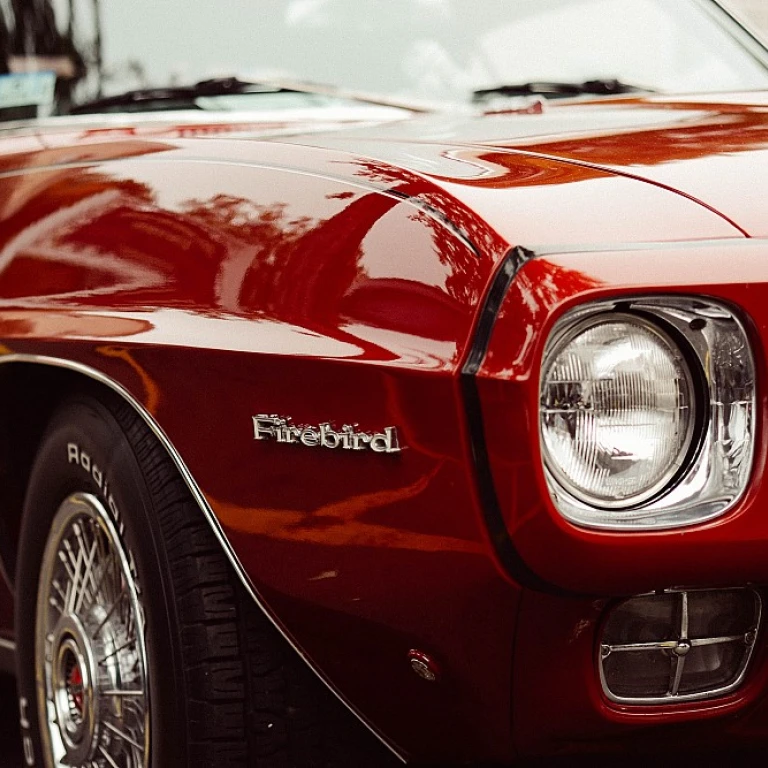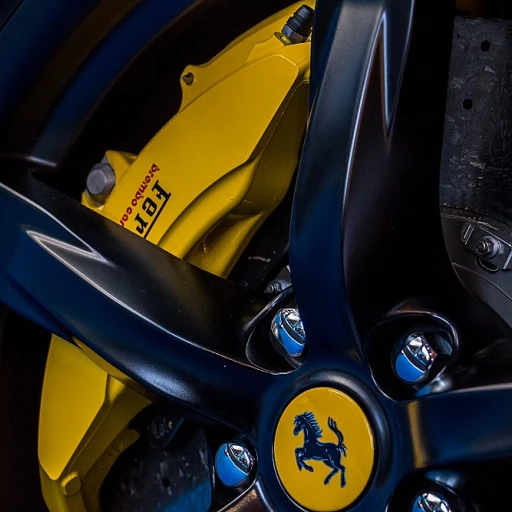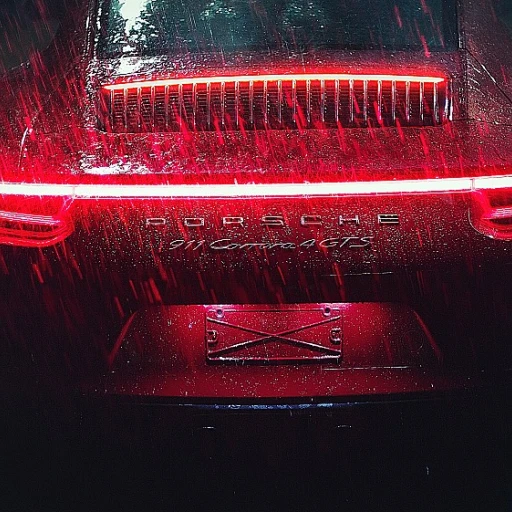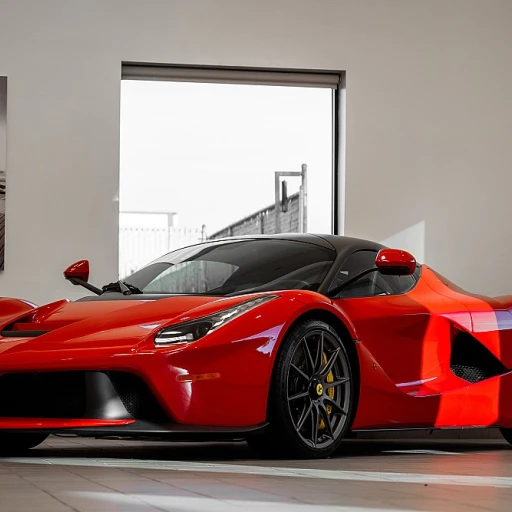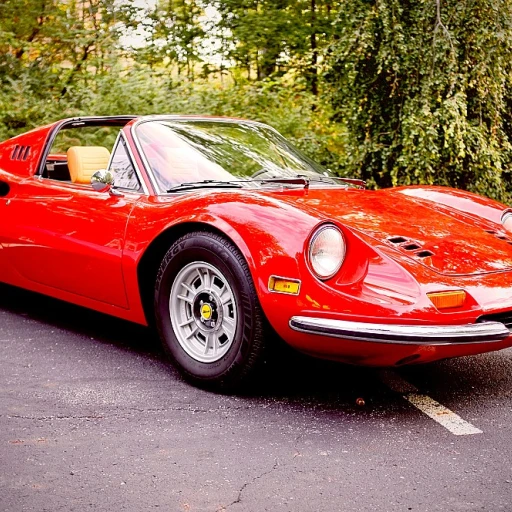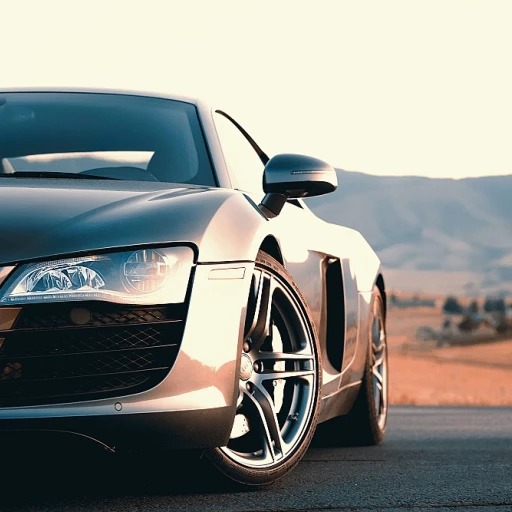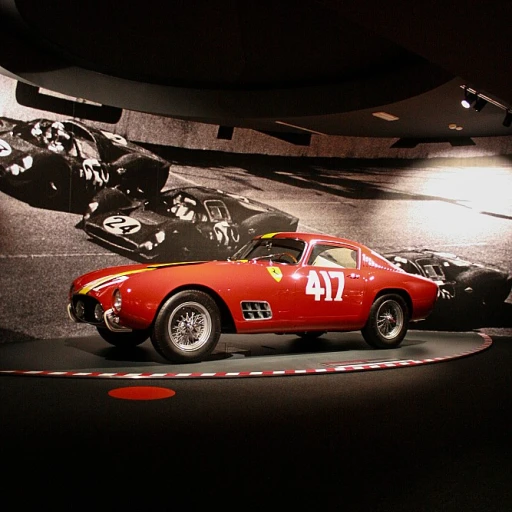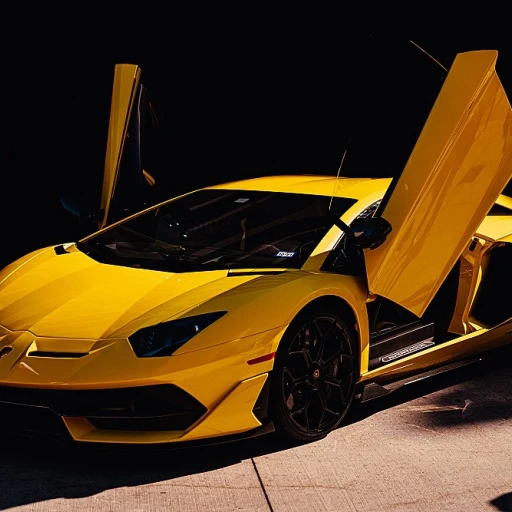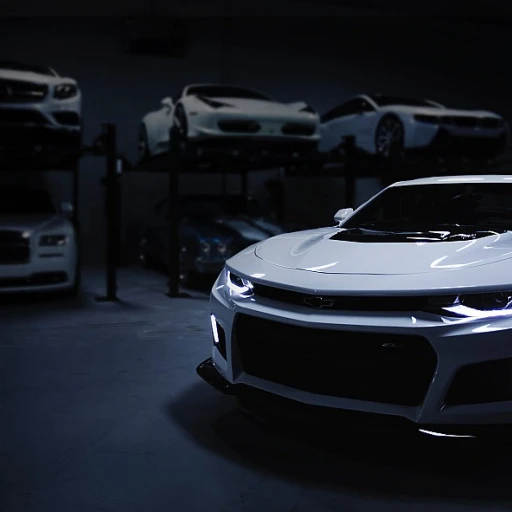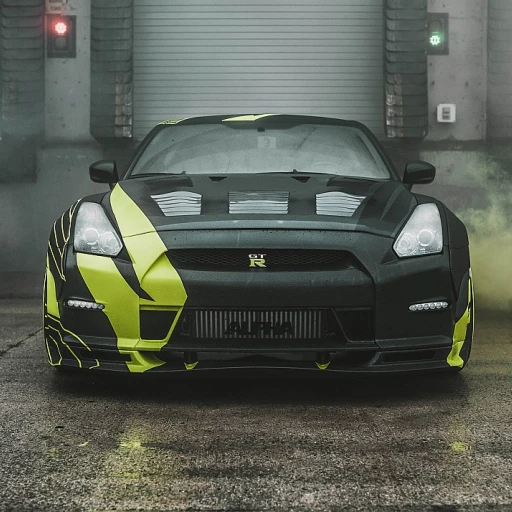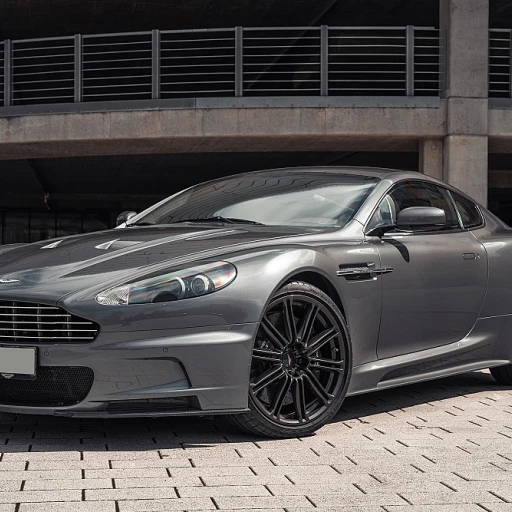
The birth of the 1950s sports car era
The dawn of sports cars: a new era in the 1950s
The 1950s marked a revolutionary period in automotive history, often regarded as the golden age of sports cars. With World War II behind them, manufacturers turned their attention to creating cars that combined performance, elegance, and innovation.Automobile innovation speeds forward
During this decade, companies like Ferrari, Porsche, Jaguar, and Mercedes-Benz introduced models that would go on to become legends. For instance, in 1954, Mercedes-Benz unveiled the 300SL Gullwing, a car that featured the world's first direct fuel injection. Jet-setting designers began creating sleek, aerodynamic shapes that not only looked stunning but also enhanced performance. This was the era where aesthetics and engineering melded beautifully, leading to some of the fastest production cars, like the Ferrari 250 Testa Rossa.Engineering marvels paving the way
Under the hoods, 1950s sports cars were nothing short of engineering masterpieces. Consider the Jaguar XKSS, equipped with a 3.4-liter engine capable of reaching a top speed of 149 mph. The Chevrolet Corvette, the first generation launched in 1953, boasted a fiberglass body and a powerful V8 engine, making it a quintessential American sports car. These cars weren't just about looks; they were about performance and innovation.A new breed of car enthusiasts emerges
The 1950s didn't just see the rise of iconic cars; it also saw the birth of a new type of car enthusiast. Car racing became popular, with events like Le Mans capturing the imagination of millions. Notably, Ferrari and Aston Martin dominated these events, fueling their reputation as world-class manufacturers. Racing legends like Stirling Moss and Juan Manuel Fangio became household names, adding to the aura of these magnificent machines.Popularity surge driven by american muscle
On the home front in the United States, the Chevrolet Corvette and the Ford Thunderbird became symbols of American ingenuity and muscle. The Corvette, often cited as the first American sports car, saw growing popularity and innovation, helping cement the U.S. as a hub for high-performance vehicles. In short, the 1950s was a defining decade for sports cars and car culture. If you're looking to explore more about how these classic car collections are preserved today, check out this historic car shows guide.Iconic designs that defined the decade
Classic designs that turned heads
The 1950s were a vibrant era for sports car design, marked by bold and innovative styles that continue to inspire car enthusiasts today. Automakers like Ferrari, Porsche, Jaguar, and Mercedes-Benz were at the forefront, creating vehicles that seamlessly combined elegance with raw performance.
One of the most iconic designs from this period is the Mercedes-Benz 300SL Gullwing. Introduced in 1954, the 300SL was renowned for its distinctive upwards-opening doors and groundbreaking fuel injection system, a first for production cars. Its 3.0L straight-six engine allowed it to reach a top speed of 163 mph, making it one of the fastest cars of its time.
Another standout was the Jaguar XK120, which earned its name by achieving a top speed of 120 mph. Released in 1948 and produced until 1954, the XK120 featured elegant curves and a powerful 3.4L inline-six engine. Its design influence is still seen in modern Jaguars, showcasing its lasting legacy.
Ferrari also made significant contributions with models like the 250 Testa Rossa and the 250 GT Berlinetta. The 250 Testa Rossa's unique pontoon fender design helped reduce weight and improve handling, leading to numerous racing victories. The Berlinetta, with its classic lines and V12 engine, remains one of Ferrari's most coveted models.
The Porsche 356, first produced in 1948 and continuing through the 1950s, established Porsche’s reputation for producing high-quality sports cars. With a rear-engine layout and an air-cooled flat-four engine, the 356 offered a blend of performance and reliability that appealed to a wide range of drivers.
American carmakers weren't left behind either; they left their mark with bold designs. The Chevrolet Corvette, introduced in 1953, became a symbol of American automotive innovation. Its fiberglass body was revolutionary, and its V8 engine provided the power and speed that sports car aficionados craved.
Another noteworthy design was the Austin-Healey 100, which merged British craftsmanship with race-ready performance. Its sleek lines and 3-speed manual overdrive transmission made it a favorite among racing enthusiasts and everyday drivers alike.
The 1950s also saw luxurious yet sporty iterations like the Cadillac Eldorado and Chevrolet Bel Air convertible. These models not only presented formidable performance but also came with the era's best in terms of comfort and style.
While European makers emphasized finesse and agility, American manufacturers focused on power and presence, resulting in a fascinating array of vehicles that continue to turn heads even decades later.
For those interested in capturing the essence of automotive elegance, you can explore the visually stunning world of these designs further by reading our post. The 1950s sports cars paved the way for the breathtaking designs we see on the roads today, merging past glory with modern innovation.
Power under the hood: engines of the 1950s
A deep dive into 1950s sports car engines: power under the hood
The introduction of high-performance engines
The 1950s marked a significant leap for sports cars with the introduction of high-performance engines that dramatically transformed speed and power capabilities. Several famous car manufacturers began developing engines that set a new standard in the automobile industry.
Double overhead camshafts
This era saw the advent of double overhead camshafts (DOHC), which significantly improved engine efficiency and performance. Alfa Romeo was among the first to champion this technology with their 1954 Alfa Romeo Giulietta Sprint. This innovation ensured improved valve timing, enhancing engine efficiency, ultimately allowing cars to achieve higher top speeds.
European craftsmanship
Europe took the lead in engine advancements with notable examples such as the Ferrari 'Colombo' V12 and Jaguar XK engine. The Ferrari 250 Testa Rossa’s V12 engine, developed by engineer Gioachino Colombo, boasted up to 300 horsepower, making it one of the most powerful sports cars of the decade. Meanwhile, the Jaguar XKSS built on the success of the XK120, integrating their renowned 3.4-liter engine delivering impressive thrust and speed up to 150 mph.
American muscle: brute force on the track
America, not to be outdone, saw impressive engine innovations as well. Chevrolet introduced their small-block V8 engine in 1955, which revolutionized American sports cars. The 1957 Chevrolet Corvette, equipped with this V8, saw its horsepower soar to 283 hp, stunning car enthusiasts worldwide with its speed and power.
Turbocharging & supercharging: early innovations
While less common, turbocharging and supercharging were experimented with during the 1950s. Mercedes-Benz showcased early supercharging with their 300 SL, known as the “Gullwing”. Sporting a 3.0-liter inline-six engine, the 300 SL used a direct fuel injection system borrowed from aircraft, one of the first to do so in a production car, enabling a top speed of 163 mph.
An expert’s take
In words of renowned automotive historian, Karl Ludvigsen - “1950s saw the maturation of engine technology, bringing unparalleled performance and creating legends on the racetracks.” This sentiment resonates with many car enthusiasts who view the era as pivotal.
Case studies
One particularly interesting case is the Aston Martin DBR1, a car that triumphed in races with its powerful straight-six engine designed by Tadek Marek. The DBR1 won the 24 Hours of Le Mans in 1959 proving the might and innovation of 1950s engineering.
Discover the impressive sports career of Nate Oats and see how his accolades relate to such historic feats.
Racing legends and their impact
Legends on the track: the racing greats of the 1950s
The 1950s weren't just about glitzy designs and powerful engines—they were also a decade where some of the most legendary races and racers left their indelible mark. Racing during this period saw the emergence of iconic sports cars that epitomized speed, style, and engineering prowess, making it a golden era for motorsports enthusiasts.
Ferrari 250 Testa Rossa: The racing icon
Few names in racing history carry as much weight as the Ferrari 250 Testa Rossa. Debuting in 1957 and dominating everywhere from Le Mans to the Mille Miglia, it became synonymous with success. Its 3.0-liter V12 engine, producing around 300 horsepower, allowed it to achieve top speeds near 167 mph. According to Ferrari historian Marcel Massini, "The Testa Rossa was a game-changer, setting new standards in engineering and performance."
Jaguar D-Type: The Le Mans legend
The Jaguar D-Type, with its sleek design and advanced aerodynamics, became a formidable presence on the racing circuit. Created specifically for Le Mans, its 3.4-liter straight-six engine helped secure three consecutive victories from 1955 to 1957. Notably, a 1955 D-Type fetched an astonishing $21.78 million at an RM Sotheby's auction in 2016, highlighting its enduring legacy.
Mercedes-Benz 300 SLR: Engineering excellence
With its innovative design and advanced technology, the Mercedes-Benz 300 SLR wasn't just a sports car; it was a technological marvel. Driven by the legendary Stirling Moss, it claimed victory at the 1955 Mille Miglia, completing the 1000-mile race at an average speed of 99 mph—a record that stands to this day. The 300 SLR's roots in the 1954 Formula One W196 R played a crucial role in its success.
Porsche 550 Spyder: The agile underdog
While it might not have looked as fierce as some of its competitors, the Porsche 550 Spyder was a giant killer on the track. Its lightweight design and rear-mid engine layout allowed for excellent handling. With its 1.5-liter flat-four engine, it proved its mettle at events like the Targa Florio and Carrera Panamericana. Tragically, the 550 Spyder is also remembered as the car in which actor James Dean met his untimely demise, further cementing its place in popular culture.
These cars weren't just mechanical wonders—they became cultural icons, shaping the world of high-speed racing and leaving a legacy that persists to this day. For more on the allure of sports cars in later decades, click here.
American muscle: the rise of the corvette
The emergence of the Chevrolet Corvette
The 1950s was an influential period for American sports cars, with the Chevrolet Corvette emerging as a significant player. Developed by General Motors, the Corvette was first introduced in 1953. It was initially produced as a show car for the 1953 Motorama display. Its sleek design and powerful performance quickly gained attention, making it one of the most iconic cars of the decade.
The Corvette's influence in the 1950s marked America's foray into sports cars, with its design reflecting the aspirations of post-war America. As General Motors aimed to capture the growing market for sports cars, they invested heavily in the Corvette's development. These investments paid off, as the car became synonymous with American performance and innovation.
Corvette design and features
From the get-go, the Corvette showcased a fiberglass body – a revolutionary feature at the time, which not only contributed to its lightweight structure but also allowed for aerodynamic shaping. One of the most undeniable aspects was its exquisite design. With a sleek, curvaceous body and a removable hardtop, it combined aesthetics with practicality. This forward-thinking design helped the Corvette stand out in a flourishing market.
Under the hood, the Corvette offered an engine that ranged from a 150 HP six-cylinder upon launch to a more powerful 283 cubic inch V8, which delivered 283 HP and helped the car reach speeds previously only dreamed of by American enthusiasts. By 1957, this engine enabled significant leaps in its performance, making the Corvette not just a 'pretty face' but a beast on the road.
Impact on car culture and racing
With its early foray into car racing, particularly in the hands of enthusiasts and professional drivers, the Corvette quickly carved a niche in competitive sports car racing. It wasn’t long before the Corvette made its mark, proving its worth on the racing tracks, thus translating that capability to road cars that enthusiasts yearned for.
Remember, Zora Arkus-Duntov, often referred to as the 'Father of the Corvette', was instrumental in enhancing its performance capabilities, pushing for the inclusion of V8 engines and advocating its use in competitions like the 12 Hours of Sebring. This endorsement helped solidify Corvette's reputation as a bona fide performer in both racing and road contexts.
Influence on european manufacturers
The Corvette's introduction and subsequent success had a ripple effect across the pond. European manufacturers, who historically led in the sports car segment, began to take note. While companies like Ferrari, Jaguar, and Porsche already had established a foothold, the wave of American competition, led by the Chevrolet Corvette, pushed these brands to innovate further.
In fact, according to a report by Automobile Magazine, the Corvette's rise played a part in spurring a competitive spirit among European brands, contributing to a golden era of sports car development that saw significant advancements in both design and performance.
Pop culture staple
Beyond the tracks and showrooms, the Corvette became a quintessential symbol of 1950s America. It found its way into movies, music, and the imagination of the public. Songs like 'Hot Rod Lincoln' and movies featuring Corvettes cemented its place not just as a car, but as a cultural icon. The aspiration to own a Corvette was as American as apple pie and baseball.
European elegance: luxury meets speed
Ferrari’s prancing horse: the epitome of europe
The 1950s was a glittering chapter for Ferrari. Establishing itself as an elite icon, Ferrari wowed with models like the 250 GT California Spyder and the 166 MM. Crafted with precision, these cars harnessed both beauty and beastly power under their hoods. The 250 GT California Spyder, for instance, is revered for its elegant design and powerful V12 engine. (Source: Ferrari Official Website)Porsche: the marque of driving pleasure
Over in Germany, Porsche was paving its own gleaming path. The Porsche 356, winner of numerous races, showcased the sleek, aerodynamic designs and could hit top speeds of around 110 mph. For many, this car epitomized the thrill of the drive. (Source: Porsche Official Website)Mercedes benz: melding luxury with performance
Not to be outdone, Mercedes-Benz was soaring to new heights with its 300 SL Gullwing. This car, known for its iconic upward-opening doors and cutting-edge fuel injection system, offered a top speed of 160 mph, making it the fastest production car of its time. (Source: Mercedes-Benz Official Site)Jaguar’s roaring success
Across the Channel, Jaguar was making waves. The Jaguar XKSS, a road-going version of its D-Type race car, stood out with its design and performance. Steve McQueen, a die-hard fan, owned one, which only added to its allure and legendary status. The car's 3.4-liter engine delivered unmatched prowess on both the track and the streets. (Source: Jaguar Official Site)Aston martin: blending british class with racing zeal
Aston Martin wasn't far behind. The DBR1 brought Aston Martin its 1959 Le Mans victory, a testament to its racing spirit. Infused with sophisticated design, models like the DB4 GT melded grace with uncompromised speed, turning heads wherever they went. (Source: Aston Martin Official Website)Lancia: the italian dark horse
While Ferrari often steals the limelight, Lancia with its Aurelia B20 GT offered an understated yet powerful alternative. Its pioneering use of V6 engines and rear-wheel drive showcased the blend of Italian elegance and performance. (Source: Lancia Official Site)The pop culture appeal
These luxury sports cars weren’t just popular on the tracks – they became integral to pop culture. Icons like James Dean, often seen in his Porsche 550 Spyder, made these cars legendary figures in the public eye. They became synonymous with fame, luxury, and the high-octane lifestyle of Hollywood. (Source: Biography of James Dean) The aura of Europe’s 1950s sports cars remains unmatched. They are symbols of an era where luxury met unparalleled speed, pushing the boundaries of automotive design and engineering.Cultural impact and pop culture appeal
1950s sports cars in films and on TV
Throughout the 1950s, sports cars were more than just performance-driven feats of engineering; they became symbols of style and freedom. This decade saw these sleek machines get embedded into films and television shows, driving their pop culture appeal to new heights. Take for instance, James Dean, the epitome of 1950s cool, who famously drove a Porsche 550 Spyder. His tragic death while driving this car only cemented the vehicle's place in pop culture. "If he was driving a sports car, it had to be cool," wrote automotive historian, Bill Lamb. The Porsche 550 Spyder remains a legendary part of car history and is evocative of Dean's rebellious image. The Chevrolet Corvette, another icon of the era, made its mark not just through performance but through appearances in TV shows such as "Route 66." With its effortless speed and iconic design, the Corvette stood as a beacon of the emerging American automotive industry. The car became a symbol of the open road and the spirit of adventure that defined 1950s America.Influence on fashion and lifestyles
Sports cars influenced more than just the screen—they seeped into the everyday lives and fashion of the era. Luxury brands like Ferrari and Maserati started launching branded merchandise, making their mark on fashion trends. A Ferrari logo on a jacket became synonymous with sophistication and a sense of adventure. Jaguar's iconic designs, particularly the Jaguar XKSS, also transformed the luxury market. Owned by celebrities like Steve McQueen, this car bridged the gap between fashion and high-performance motoring. McQueen's ownership of the XKSS turned it into an enduring symbol of style and speed.Music and literature
Music and literature of the 1950s didn't escape the influence of these sports cars, either. Iconic rock 'n' roll songs often referenced these high-speed machines. Classics like Chuck Berry's "Maybellene" narrate tales of fast cars and even faster lifestyles. In literature, sports cars became symbols of freedom and rebellion. Jack Kerouac's "On the Road" captured the essence of the decade, with cars representing the pursuit of freedom and self-identity. The cars weren't just vehicles; they were characters in their own right, steering the narrative of an entire generation.Today's appreciation for 1950s sports cars
The allure of 1950s sports cars continues to captivate enthusiasts and collectors today. Vehicles like the Austin Healey and Alfa Romeo Giulietta Spider remain popular in classic car collections and auctions. These cars symbolize a golden era of design and performance that modern vehicles strive to emulate. Events like Pebble Beach Concours d'Elegance showcase the lasting appeal of these classic beauties. The fact that they continue to draw admiration and high bids speaks volumes about their lasting impact. Collectors value these cars not just for their design and performance, but for the cultural stories they carry. 1950s sports cars were more than just vehicles. They were cultural icons, symbols of freedom, and markers of style that influenced movies, TV, fashion, music, and literature. Their legacy lives on not just in museums and private collections but in the spirit of modern automotive design.Preserving the legacy: classic car collections
A trip down memory lane
The 1950s were an era of striking innovation in sports cars and the fever for these beauties still burns bright among enthusiasts. As we journey back, it becomes clear why these models are not just machines but stories of passion.
Why collectors are spellbound
For many, owning a classic 1950s sports car is akin to holding a piece of history. Take the Mercedes Benz Gullwing, for instance. Its distinct doors and performance agility made it one of the fastest production cars of its time. Collectors like Jay Leno and Ralph Lauren have over the years shared their admiration for such timeless beauties.
Iconic figures and their machines
The pull of these cars isn't just in their metal and horsepower. It's the legends behind the wheel too. James Dean and his Porsche 550 Spyder, dubbed the "Little Bastard," is a saga forever etched in popular culture. These cars don’t just represent a mode of transport; they embody a blend of speed, freedom, and rebellion.
The value of preservation
Car clubs and collections around the globe are dedicated to preserving the legacy of these classic automobiles. The Jaguar XKSS and the Aston Martin DBR, for example, are stars in such collections. According to a report from Hagerty, vintage sports cars from the '50s have seen a significant rise in value, some appreciating over 30% in the last decade.
Modern tributes
In today's market, manufacturers sometimes pay homage to these golden era marvels. The Chevrolet Corvette, originally launched in 1953, has modern versions that capture its classic spirit while boasting contemporary tech. Even Ferrari's modern designs draw lines back to their 1950s forebears, keeping the essence of speed and style alive.
A cultural phenomenon
Beyond the asphalt, these cars have left rubber marks on the cultural tapestry of the U.S. and Europe. Movies, TV shows, and even music have immortalized them. Take Cadillac Eldorado's regular feature in rock 'n' roll anthems as a prime example. The very names of these cars – Lancia Aurelia, Austin Healey – evoke a sense of nostalgia and class.
Gathering of enthusiasts
Events such as the Pebble Beach Concours d'Elegance gather aficionados from around the globe, a testament to the ever-enduring love for these vehicles. Enthusiasts share stories, exchange collectibles, and display meticulously restored cars that often become the centerpiece of such gatherings.
Final thoughts
Whether it’s the American powerhouses or the European marvels, 1950s sports cars emphasize that some loves never die. Amid the smell of engine oil and the gleam of polished chrome, we’re reminded that these aren't just cars; they’re legends on four wheels.

